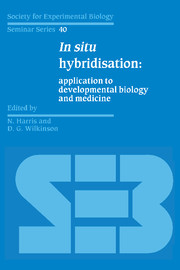Book contents
- Frontmatter
- Contents
- List of contributors
- Preface
- Non-radioisotopic labels for in situ hybridisation histochemistry: a histochemist's view.
- Use of haptenised nucleic acid probes in fluorescent in situ hybridisation
- The use of complementary RNA probes for the identification and localisation of peptide messenger RNA in the diffuse neuroendocrine system
- Contributions of the spatial analysis of gene expression to the study of sea urchin development
- Advantages and limitations of in situ hybridisation as exemplified by the molecular genetic analysis of Drosophila development
- The use of in situ hybridisation to study the localisation of maternal mRNAs during Xenopus oogenesis
- In situ hybridisation in the analysis of genes with potential roles in mouse embryogenesis
- Evolution of algal plastids from eukaryotic endosymbionts
- Localisation of expression of male flower-specific genes from maize by in situ hybridisation
- Tissue preparation techniques for in situ hybridisation studies of storage-protein gene expression during pea seed development
- Investigation of gene expression during plant gametogenesis by in situ hybridisation
- Sexing the human conceptus by in situ hybridisation
- Non-isotopic in situ hybridisation in human pathology
- The demonstration of viral DNA in human tissues by in situ DNA hybridisation
- Index
The use of in situ hybridisation to study the localisation of maternal mRNAs during Xenopus oogenesis
Published online by Cambridge University Press: 04 August 2010
- Frontmatter
- Contents
- List of contributors
- Preface
- Non-radioisotopic labels for in situ hybridisation histochemistry: a histochemist's view.
- Use of haptenised nucleic acid probes in fluorescent in situ hybridisation
- The use of complementary RNA probes for the identification and localisation of peptide messenger RNA in the diffuse neuroendocrine system
- Contributions of the spatial analysis of gene expression to the study of sea urchin development
- Advantages and limitations of in situ hybridisation as exemplified by the molecular genetic analysis of Drosophila development
- The use of in situ hybridisation to study the localisation of maternal mRNAs during Xenopus oogenesis
- In situ hybridisation in the analysis of genes with potential roles in mouse embryogenesis
- Evolution of algal plastids from eukaryotic endosymbionts
- Localisation of expression of male flower-specific genes from maize by in situ hybridisation
- Tissue preparation techniques for in situ hybridisation studies of storage-protein gene expression during pea seed development
- Investigation of gene expression during plant gametogenesis by in situ hybridisation
- Sexing the human conceptus by in situ hybridisation
- Non-isotopic in situ hybridisation in human pathology
- The demonstration of viral DNA in human tissues by in situ DNA hybridisation
- Index
Summary
Introduction
A method for in situ hybridisation using Xenopus laevis oocytes is described in detail. Using this technique, we have studied the distribution of several localised maternal mRNAs during Xenopus oogenesis. Our results suggest that all of the RNAs tested, including mRNAs localised to either the animal or vegetal ends of oocytes, are evenly distributed during early oogenesis. Localisation begins during the middle stages of oogenesis, and full-grown oocytes demonstrate the most striking localisation.
One parameter that can be used to identify a gene whose product is developmentally important is the spatial pattern of its transcript. In situ hybridisation is a method commonly used for determining the spatial localisation of any relatively abundant gene transcript. Although this procedure cannot be used to detect low abundance mRNAs, and can be hindered by fixation artefacts, it can be a very useful method, particularly in conjunction with other techniques.
There are many experiments in which in situ hybridisation has been used to study how genes are expressed during development. For example, these experiments have been particularly informative with respect to the expression of homeobox genes of Drosophila (for review see Akam, 1987). In these cases this technique has been utilised in conjunction with the analysis of mutant phenotypes. In situ hybridisation has also been used in sea urchins with histone genes (Angerer et al., 1984; Venezky et al., 1981;Cox et al., 1984) transcripts of which are localised to the pronucleus until its breakdown following meiotic prophase.
- Type
- Chapter
- Information
- In Situ HybridisationApplication to Developmental Biology and Medicine, pp. 115 - 130Publisher: Cambridge University PressPrint publication year: 1990
- 5
- Cited by



